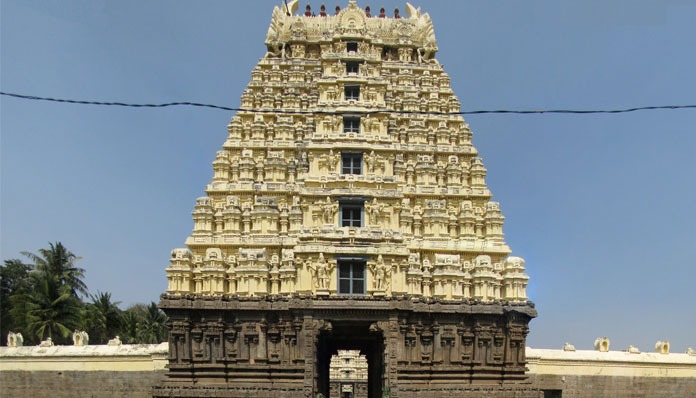HINDUTVA IN TAMIL NADU
– TAMILARS’ EFFORTS TO SAVE TEMPLES
Dr.M.VIJAYA
Academician, Author, Columnist and Social Worker
Tamilagam is basically a Sanathana Bhoomi and Hindutva – the duty to guard the Bharat Bhoomi (Land) and the Sanathana Dharma of this spiritual Land – is in the blood and gene of Tamilars since ages past. Few instances of the struggle Tamilagam underwent in the process of saving the Temples are as follows:
INVASION OF KALABHRAS:
In the 3rd to 6th Centuries CE, towards the end of the last Sangam period, Tamizhagam was under the attack of the Kalabhras who came from beyond the Northern mountains probably through the Tirupati hills. They were depicted as ‘Kali arasars’ meaning ‘bad kings. They captured the Velvikudi village was a Brahmadeya land and disturbed the tribal settlements along the rivers and sea coast. During the Kalabhra invasion, many Temples were destroyed till the Cholas and Pandyas defeated them and took control of Tamilagam to save and build new Temples.
PROTECTING JALAKANDESWARAR:
400 years back, Jalakandeswarar Temple located in the Vellore Fort, was under attack of the Mughal invaders. Fearing desecration, the idol of the main Deity – Jalakandeswarar (Lord Shiva) was hidden by the pundit of the Temple, in a secret place in the nearby Jalakanda Vinayaka Temple. Years passed by and the Britishers took control of the Temple. They handed it over to the archaeological department. For years together, the temple building was used as arsenal. In early 1920s, a request was placed to reinstall the Jalakandeswarar idol back in the sanctum of the temple which the authorities refused. However, in 1981, the idol was removed from the Jalakanda Vinayaka Temple, brought it inside the Temple and reinstated in its original sanctum under the efforts of Guruji Mailai Sundaram.
DIVINE SACRIFICE OF 12,000 DEVOTEES AND VELLAYI:
In 1323 when the Sultanate forces came to plunder Srirangam Temple, 12,000 devotees who were civilians, sacrificed their lives in guarding the Temple against the invasion. To protect the idol of Namperumal which the invaders wanted to seize, Pilailokacharya took the idol and fled. Knowing that the Acharya would not have fled to a far-off distance, a Devadasi named Vellayi diverted the Sultanate commander to halt and watch her dance. She danced for hours together and finally luring him that she would show the place where treasure was hidden, she took him to a top floor of the Eastern Gopuram, pushed him down to the ground and she herself jumped to prefer suicide than being captured by the Sultan’s army for killing the commander. In remembrance of the great sacrifice done by Vellayi, the Eastern Gopuram has been named ‘Vellayi Gopuram’ and is painted White which symbolises Vellayi where ‘Vellai’ in her name means ‘white’.
BURIED SHIVALINGAM AND NANDIKESWAR IN AGRICULTURAL FIELD:
In the village named Ramani Mudali Pudur near Pollachi, there was an Iswarar Kovil (Lord Shiva’s Temple) which was destroyed by Tipu Sultan during his conquest of Travancore in late 1770s. the original Temple before mutilation, was built by Veeraraghava Chola in 816CE housing a Shivalingam in its sanctum. During the invasion of Tipu, the Acharya of the Temple took the Shivalingam and the Nandikesawar idols from the Temple and buried them in an agricultural field nearby so as to protect the Deities from being destroyed by the invader. Later in 1996, by some divine ordain, a Sanyasi got the idols unearthed from beneath the ground under a 750-year-old Vaagai tree and reinstated it. Since then, regular poojas are held for Lingeswar and Nadikeswar.
MARUTHU BROTHERS SURRENDERED TO SAVE KALAIYAR TEMPLE:
The history of the sacrifice made by the Maruthu Pandya brothers for the sake of the Kalaiyar Temple should not be forgotten. Kalaiyar Kovil (Kaaleswarar Temple) situated at Sivaganagai near Madurai, is believed to be the place where Maa Kaali who after killing Chandasurar gained the Black complexion as a curse, worshipped Lord Shiva and took bath in the Sivagangai Theertham to regain Her complexion. She turned to the golden complexion and thus gained the name Swarnavalli (‘Swarna’ means gold) which is the name of the Female Deity of the Temple. This Kalaiyar Temple is one of the important Shivasthalams where sages like Agasthiyar worshipped the main Deity Kaaleeswarar and on whose praise, several hymns were written by ancient Tamil poets like Thirunaavukarasar and Thirugnana Sambandar. Such a historically important Temple was under the invasion of the British colonizers on 25 June, 1772. Raja Muthu Vadagunathar Thevar and his soldiers lost their lives in their attempt to protect the Temple from the British invasion. The Englishmen plundered the wealth from the Temple and left. Later in 1801, the valorous Maruthu Pandya brothers are said to have surrendered themselves to the British in the process of saving the Kalaiyar Temple due to which they were hanged to death and hundreds of their family members were also killed.
Such are the few examples from the pages of history to show that people of Tamilagam – Kings, Pundits and general public have all always been spiritual people and due to which, people of Tamilagam sacrificed even their lives to safeguard Sanathana Dharma of Hindutva in this Southernmost soil of the Punya Bhoomi (Holy Land) – Bharat. Should their sacrifices be in vain?

